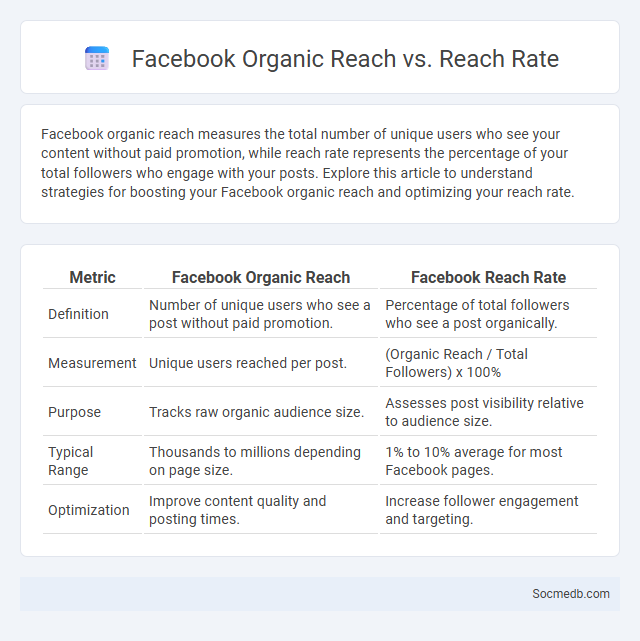
Photo illustration: Facebook Organic Reach vs Reach Rate
Facebook organic reach measures the total number of unique users who see your content without paid promotion, while reach rate represents the percentage of your total followers who engage with your posts. Explore this article to understand strategies for boosting your Facebook organic reach and optimizing your reach rate.
Table of Comparison
| Metric | Facebook Organic Reach | Facebook Reach Rate |
|---|---|---|
| Definition | Number of unique users who see a post without paid promotion. | Percentage of total followers who see a post organically. |
| Measurement | Unique users reached per post. | (Organic Reach / Total Followers) x 100% |
| Purpose | Tracks raw organic audience size. | Assesses post visibility relative to audience size. |
| Typical Range | Thousands to millions depending on page size. | 1% to 10% average for most Facebook pages. |
| Optimization | Improve content quality and posting times. | Increase follower engagement and targeting. |
Understanding Facebook Organic Reach
Facebook organic reach measures the number of unique users who see your content without paid promotion, influenced by factors such as engagement, relevance, and post type. Algorithms prioritize content from friends, family, and groups, making authentic interactions crucial for expanding your visibility. By creating high-quality, engaging posts tailored to your audience's interests, you can enhance your Facebook organic reach and foster stronger connections.
What is Reach Rate on Facebook?
Reach Rate on Facebook measures the percentage of your unique audience that sees your content compared to your total follower count. Your Reach Rate is a critical metric for understanding how effectively your posts are being distributed and engaging within the Facebook algorithm. Improving this rate helps increase visibility, brand awareness, and the overall impact of your social media strategy.
Key Differences Between Organic Reach and Reach Rate
Organic reach measures the total number of unique users who see your content without paid promotion, reflecting natural audience engagement on platforms like Facebook or Instagram. Reach rate calculates the percentage of your total followers who have viewed your content, offering insight into the effectiveness of your posts relative to your audience size. Understanding the distinction helps marketers optimize content strategies by balancing authentic engagement with targeted reach improvements.
How Facebook Organic Reach is Calculated
Facebook organic reach is calculated based on the number of unique users who see your content without paid promotion. The algorithm factors in user engagement metrics such as likes, comments, shares, and the relevance of the content to each user's interests. Frequency of interaction between the user and the content creator and the overall quality and recency of posts also significantly influence organic reach on the platform.
Factors Influencing Organic Reach on Facebook
Organic reach on Facebook is influenced predominantly by the platform's algorithm, which prioritizes content based on user engagement such as likes, comments, and shares. Posting frequency, content relevance, and the use of targeted keywords also play critical roles in enhancing visibility within users' news feeds. Furthermore, the timing of posts aligned with audience activity patterns significantly impacts organic reach performance.
Analyzing the Importance of Reach Rate
Reach rate measures the percentage of unique users who see your social media content, serving as a critical metric for evaluating visibility and audience engagement. Analyzing your reach rate helps identify how effectively your posts connect with your target demographic, enabling optimization of content strategies for maximum impact. Tracking this metric ensures your brand presence grows organically and marketing efforts deliver tangible results.
Common Misconceptions About Facebook Reach
Facebook reach often gets misunderstood, with many assuming organic reach is as extensive as before the algorithm changes in 2018. The average organic reach for a Facebook Page now hovers around 5.2% per post, significantly lower than past levels due to prioritization of meaningful interactions. Brands must leverage paid ads and engagement strategies to maximize visibility, as relying solely on organic reach limits audience size drastically.
Best Practices to Improve Organic Reach and Reach Rate
Maximize your organic reach on social media by consistently creating high-quality, engaging content tailored to your target audience's interests and behaviors. Utilize platform-specific features such as hashtags, Stories, reels, and community engagement tools to boost visibility without paid ads. Analyzing your reach rate through native analytics helps refine posting times and content formats, ensuring your posts resonate and expand your audience organically.
Metrics to Track for Facebook Page Success
Tracking key metrics such as engagement rate, reach, and click-through rate is essential to measure the success of your Facebook page. Monitoring page likes, post shares, and comments helps you understand audience interaction and content relevance. Analyzing these performance indicators allows you to optimize your social media strategy and grow your online presence effectively.
Future Trends in Facebook Organic Reach and Reach Rate
Facebook organic reach is projected to decline as the platform prioritizes personalized content and user engagement through advanced AI algorithms. Emerging trends indicate a growing emphasis on video content and community-based interactions to maintain or boost reach rates organically. Marketers must adapt by leveraging interactive features like Facebook Groups and Stories to counteract the decreasing visibility of traditional posts.
 socmedb.com
socmedb.com